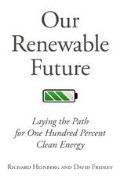Abstract
THIS BOOK IS ESSENTIALLY a thought exercise designed to explore some of the issues involved in transitioning our economy to 100 percent renewable energy. Some readers may chafe at the boundaries of this exercise. Why rely so much on wind and solar, rather than envisioning a more diverse mix of low-carbon energy sources? We chose our framework because it was simple and clear, and because this is a future that is indeed being widely proposed. The state of Vermont, for example, has announced the official goal of sourcing 90 percent of all its energy (not just electricity) from renewable sources—mostly solar and wind—by 2050. Moreover, studies have been published purporting to show that a 100 percent wind, solar, and hydro energy regime is both possible and affordable, and prominent climate-oriented environmental organizations are now calling for that goal. Further, we ourselves believe that a full transition to renewables is necessary and achievable, provided society is willing to accept adjustments, both profound and minor, to the ways it uses energy.
Notes
- 1.
Mark Z. Jacobson et al., “100 % Clean and Renewable Wind, Water, and Sunlight (WWS) all-sector energy roadmaps for the 50 United States,” Energy and Environmental Science 8, no. 7 (2015): 2093–2117.”
- 2.
Michael Brune, “All In,” Sierra Magazine, January/February 2014, http://www.sierraclub.org/sierra/2014-1-january-february/feature/all.
- 3.
Werner Zittel, Jan Zerhusen, and Martin Zerta, Fossil and Nuclear Fuels—the Supply Outlook (Ottobrunn, Germany: Energy Watch Group, 2013), http://energywatchgroup.org/wp-content/uploads/2014/02/EWG-update2013_long_18_03_2013up1.pdf.
- 4.
Gavin Mudd, “The Future of Yellowcake: A Global Assessment of Uranium Resources and Mining,” Science of the Total Environment 472 (2014): 590–607, doi:10.1016/j.scitotenv.2013.11.070.
- 5.
Charles Hall and Bobby Powers, “The Energy Return of Nuclear Power. (EROI on the Web—Part 4 of 5),” Oil Drum, April 22, 2008, http://www.theoildrum.com/node/3877.
- 6.
Dino Grandoni, “Why It’s Taking the U.S. So Long to Make Fusion Energy Work,” Huffington Post, January 20, 2015, http://www.huffingtonpost.com/2015/01/20/fusion-energy-reactor_n_6438772.html.
- 7.
International Energy Agency, Cost and Performance of Carbon Dioxide Capture from Power Generation (Paris: OECD/IEA, 2011), http://www.iea.org/publications/freepublications/publication/cost-and-performance-of-carbon-dioxide-capture-from-power-generation.html.
- 8.
This is our own calculation, based on the following sources. Density of compressed CO2 in CCS: David McCollum and Joan Ogden, Techno-economic Models for Carbon Dioxide Compression, Transport, and Storage & Correlations for Estimating Carbon Dioxide Density and Viscosity, Institute for Transportation Studies, University of California–Davis, October 2006. Consumption of coal: U.S. Energy Information Administration, “Table 32. U.S. Coal Consumption by End-Use Sector, 2008–2014,” accessed October 3, 2015, http://www.eia.gov/coal/production/quarterly/pdf/t32p01p1.pdf. Coal emissions factor: U.S. Energy Information Administration, “Carbon Dioxide Emissions Coefficients,” accessed October 3, 2015, http://www.eia.gov/environment/emissions/co2_vol_mass.cfm.
- 9.
This source (the U.S. Energy Information Administration’s Annual Energy Outlook 2015) projects a 52 percent average premium of “advanced coal” with CCS over conventional coal, in terms of the levelized cost of electricity in $/MWh, http://www.eia.gov/forecasts/aeo/pdf/electricity_generation.pdf (see table 1). Table 2 shows minimum and maximum ranges, from 12 to 84 percent for coal CCS versus coal.
- 10.
Richard Heinberg and Howard Herzog, “Does ‘Clean Coal’ Technology Have a Future?” Wall Street Journal, November 23, 2014, http://www.wsj.com/articles/does-clean-coal-technology-have-a-future-1416779351.
- 11.
Jack Kittredge, Soil Carbon Restoration: Can Biology Do the Job? (Northeast Organic Farming Association, August 2015), http://www.nofamass.org/content/soil-carbon-restoration-can-biology-do-job.
- 12.
R. A. Houghton, Brett Byers, and Alexander Nassikas, “A Role for Tropical Forests in Stabilizing Atmospheric CO2,” Nature Climate Change 5 (2015): 1022–23, http://www.nature.com/nclimate/journal/v5/n12/full/nclimate2869.html.
- 13.
Jamie Lendino, “This Fully Transparent Solar Cell Could Make Every Window and Screen a Power Source (updated),” ExtremeTech, April 20, 2015, http://www.extremetech.com/extreme/188667-a-fully-transparent-solar-cell-that-could-make-every-window-and-screen-a-power-source.
- 14.
Unlike microprocessors, which have a short design cycle and short lifetime on average, macrolevel technology is completely different. Coauthor David Fridley conducted an informal survey of his colleagues at Lawrence Berkeley National Laboratory on their estimation of the average time from benchtop proof-of-concept to commercialization with market impact; the answers averaged 25 to 30 years. This is true for many technologies: the first U.S. patent for solar cells was issued in 1888, Bell Labs was producing solar cells for the space program in the 1950s, and the first polysilicon solar cells as used today were produced in 1982. In other words, what we know now is pretty much what’s available for us to build on; or, if it hasn’t been invented yet, you’re working on faith, not science. (This equally applies to the “black swan” type discoveries.)
- 15.
Avaneesh Pandey, “Artificial Photosynthesis System Created From a Nano-wire-Bacteria Hybrid,” International Business Times, April 17, 2015, http://www.ibtimes.com/artificial-photosynthesis-system-created-nanowire-bacteria-hybrid-1886068.
- 16.
Vaclav Smil, Energy Transitions: History, Requirements, Prospects (Santa Barbara: Praeger, 2010).
- 17.
See, for example, Linda Federico-O’Murchu, “How 3-D Printing Will Radically Change the World,” CNBC, May 11, 2014, http://www.cnbc.com/2014/05/09/will-3-d-technology-radically-change-the-world.html
Rights and permissions
Copyright information
© 2016 Post Carbon Institute
About this chapter
Cite this chapter
Heinberg, R., Fridley, D. (2016). What About . . . ?. In: Our Renewable Future. Island Press, Washington, DC. https://doi.org/10.5822/978-1-61091-780-3_8
Download citation
DOI: https://doi.org/10.5822/978-1-61091-780-3_8
Publisher Name: Island Press, Washington, DC
Print ISBN: 978-1-61091-831-2
Online ISBN: 978-1-61091-780-3
eBook Packages: Earth and Environmental ScienceEarth and Environmental Science (R0)

